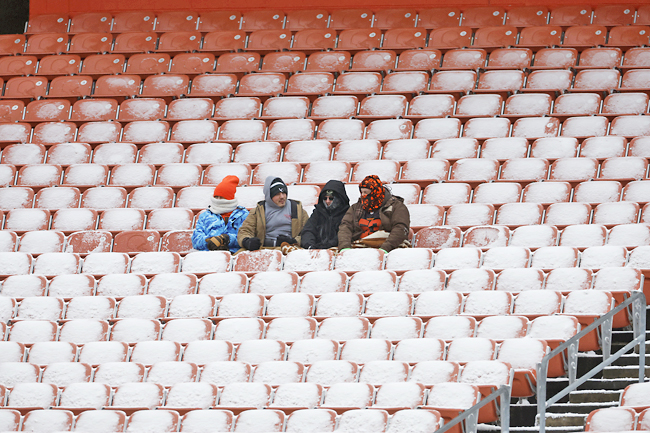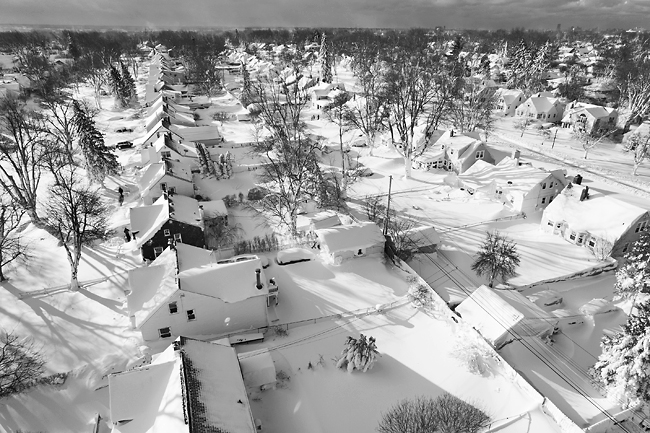Carolyn Thompson & Jake Bleiberg
BUFFALO (AP) – The deep freeze from a deadly winter storm that walloped much of the United States (US) will continue into the week as people in western New York deal with massive snow drifts that snarled emergency vehicles and travellers across the country see cancelled flights and dangerous roads.
The massive storm has killed at least 34 people across the US and is expected to claim more lives after trapping some residents inside houses and knocking out power to tens of thousands of homes and businesses.
The extreme weather stretched from the Great Lakes near Canada to the Rio Grande along the border with Mexico. About 60 per cent of the US population faced some sort of winter weather advisory or warning, and temperatures plummeted drastically below normal from east of the Rocky Mountains to the Appalachians.
The National Weather Service said on Sunday the frigid arctic air “enveloping much of the eastern half of the US will be slow to moderate”.
That’s especially unwelcome news for Buffalo, which saw hurricane-force winds and snow causing whiteout conditions that paralysed emergency response efforts.



New York Governor Kathy Hochul said almost every fire truck in the city was stranded on Saturday and implored people on Sunday to respect an ongoing driving ban in the region.
Officials said the airport would be shut through Tuesday morning. The National Weather Service said the snow total at the Buffalo Niagara International Airport stood at 109 centimetres at 7am on Sunday.
Huge snowdrifts nearly covered cars and there were thousands of houses, some adorned in unlit holiday displays, dark from a lack of power.
With snow swirling down untouched and impassable streets, forecasters warned an additional 30 to 60 centimetres of snow was possible in some areas through early Monday morning amid wind gusts of 64 kilometres per hour (kph). Police said on Sunday evening that there were two “isolated” instances of looting during the storm.
Two people died in their suburban Cheektowaga, New York, homes on Friday when emergency crews could not reach them in time to treat their medical conditions. Erie County Executive Mark Poloncarz said 10 more people died there during the storm, including six in Buffalo, and warned there may be more dead.
“Some were found in cars, some were found on the street in snowbanks,” Poloncarz said.
“We know there are people who have been stuck in cars for more than two days.”
Freezing conditions and power outages had Buffalonians scrambling to get to anywhere with heat amid what Hochul called the longest sustained blizzard conditions ever in the city.
But with streets under a thick blanket of white, that wasn’t an option for people like Jeremy Manahan, who charged his phone in his parked car after almost 29 hours without electricity.
“There’s one warming shelter, but that would be too far for me to get to. I can’t drive, obviously, because I’m stuck,” Manahan said. “And you can’t be outside for more than 10 minutes without getting frostbit.”
Ditjak Ilunga of Gaithersburg, Maryland, was on his way to visit relatives in Hamilton, Ontario, for the festive season with his daughters on Friday when their SUV was trapped in Buffalo. Unable to get help, they spent hours with the engine running, buffeted by wind and nearly buried in snow.
By 4am on Saturday, their fuel nearly gone, Ilunga made a desperate choice to risk the howling storm to reach a nearby shelter. He carried six-year-old Destiny on his back while 16-year-old Cindy clutched their Pomeranian puppy, following his footprints through drifts.
“If I stay in this car I’m going to die here with my kids,” Ilunga recalled thinking. He cried when the family walked through the shelter doors. “It’s something I will never forget in my life.”
Travellers’ weather woes continued, with hundreds of flight cancellations already and more expected after a bomb cyclone – when atmospheric pressure drops very quickly in a strong storm – developed near the Great Lakes, stirring up blizzard conditions, including heavy winds and snow.
The storm knocked out power in communities from Maine to Seattle. But heat and lights were steadily being restored across the US. According to poweroutage.us, less than 200,000 customers were without power on Sunday at 3pm EDT – down from a peak of 1.7 million.
Concerns about rolling blackouts across eastern states subsided on Sunday after PJM Interconnection said its utilities could meet the day’s peak electricity demand. The mid-Atlantic grid operator had called for its 65 million consumers to conserve energy amid the freeze on Saturday.
Storm-related deaths were reported in recent days all over the country: 12 in Erie County, New York, ranging in age from 26 to 93 years old, and another in Niagara County where a 27-year-old man was overcome by carbon monoxide after snow blocked his furnace; 10 in Ohio, including an electrocuted utility worker and those killed in multiple car crashes; six motorists killed in crashes in Missouri, Kansas and Kentucky; a Vermont woman struck by a falling branch; an apparently homeless man found amid Colorado’s subzero temperatures; and a woman who fell through Wisconsin river ice.
In Jackson, Mississippi, city officials on the weekend announced residents must now boil their drinking water due to water lines bursting in the frigid temperatures.







